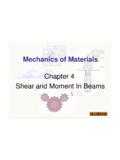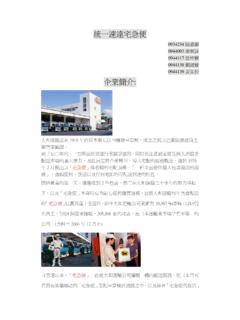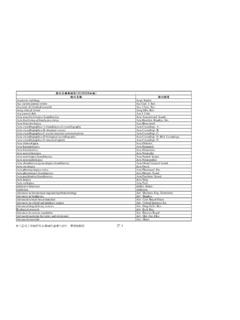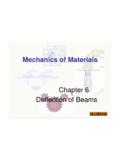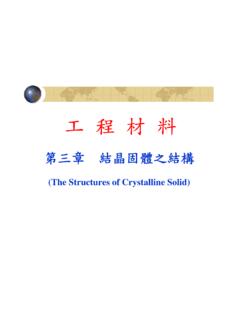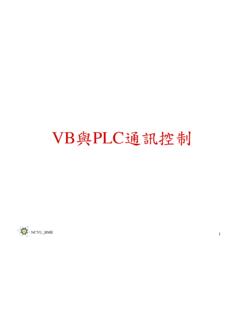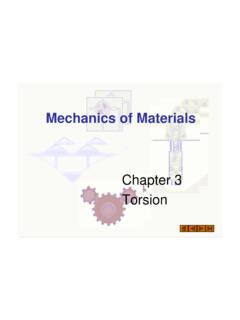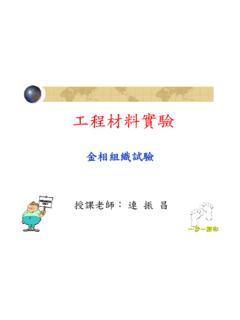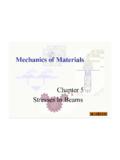Transcription of Chapter 2 Strain - ncyu.edu.tw
1 Mechanics of MaterialsChapter Introduction So far dealt mainly with thestrengthof structural member. Here we being our study of an equally important topic of mechanics deformations, orstrains. In general terms, strainis a geometric quantity that measures thedeformation of a body. There are two types of Strain normal Strain , which characterizes dimensional changes, and shear Strain , which describes distortion (changes in angles). Stress and strainare twofundamental concepts of mechanics of materials. Their relationship to each other defines the mechanical properties of a material, the knowledge of which is of the utmost importance in design. Use force-deformation relationships in conjunction with equilibrium analysis to solve statically Axial Deformation Stress- Strain Diagram The strength of a materialis not the only criterionthat must be considered when designing machineparts or structures.
2 The stiffness of a materialis often equally important propertiessuch as hardness, toughness, and properties are determined by laboratory tests. Many materials, particularly metals, have established standardsthat describe the test procedures in detail. We will confine ourattention to only one of the tests the tensile test of steel and use its resultsto illustrate several important concepts of material Normal (axial) Strain Theelongation may be causedby an applied axial force, or anexpansiondue to an increase in temperature, or even a force and a temperatureincrease acting simultaneously. Strain describes the geometry of deformation. The normal Strain (lowercase Greek epsilon) is defined as theelongationper unit length. Therefore, the normal strainin the bar in the axial direction, also known as the axial Strain , is ( )L =Figure Deformation of a prismatic bar.
3 If the bar deforms uniformly, then Eq. ( ) expression should be viewed as the average axial Strain . Note that normal Strain , being elongation per unit length, is a dimensionless quantity. However, units such as or mm/mmare frequently used for normal Strain . If the deformation is not uniform, we let Obe a point in the bar located at the distance from the fixed end. We define the axial Strain at point Oas ( ) ddox= = lim We note that if the distribution of the axial Strain is known, the elongation of the can be computed from( )For uniform Strain distribution, Eq. ( ) yields = L, which agrees with Eq.( ). The results are also applicable to compression. By convention, compression (shortening) carries a negative sign. ==LOLOdd b. Tension test In the standard tension test, the specimen shown in is placed in the grips of a testing machine.
4 The grips are designedso that the loadPapplied by the machine is axial. Two gage marks are scribed on the specimen to define the gage length L. These marks are loaded away from the ends to avoid the load effectscaused by the grips and to ensure that the stress and Strain are uniform in the material between the marks. The testing machine elongates the specimen at a slow, constant rateuntil the specimen ruptures. ()g()gFigure Specimen used in the standard tension test. During the test, continuous readings are taken of the applied loadand the elongationof the gage data are then converted to stress and Strain . The stress is obtained from =P/A, where Pis the load and Arepresents the original cross-sectional areaof the specimen. The Strain is computed from = /L, where is the elongation where is the elongation Between the gage marks and L is the original gage length.
5 There results are referred toas nominal stressand nominal Strain . As the bar is being stretched, its cross-sectional areais reduced and thelengthbetween the gage marksincreases. Dividing the loadby the actual (current) area of the specimen, we get the true , thetrue strainis obtained by dividing the elongation by the current gage length. The nominaland truemeasures are essentially the same in the working range of metals. They differ only for very large strains, With only a few exceptions, engineering applications use nominalstress and Strain . ()gg()ggFigure Stress- Strain diagram obtained from the standard tension test on a structural steel specimen. A stress- Strain diagram for structural steel is shown in Fig. The following mechanical properties can be determined from the Limit and Hooke s Law As seen in Fig.
6 , the stress- Strain diagram is a straight linefrom the origin O to a point called the proportional limit. This plot is a manifestation of Hooke s law : Stress is proportional to Strain ; that is, = E ( )whereEis material property known as the modulus of elasticityorYoung s units of Eare the same asthe units of, Pa or psi. For steel, E=29 106 psi, or 200 GPa, approximately. Note that Hooke slawdoes notapply to the entire diagram its validity ends at the proportional limit. Beyond this point, stress is no longer proportional to Strain .()gg()gg Elastic LimitA material is said to be elasticif, after being loaded, the material returns to its original shapewhen the load is removed. The stress beyond which the material is no longer elastic. The permanent deformation that remains after the removal of the load is called the permanent set.
7 The elastic limit is slightly larger thanthe proportional limit. Yield PointThe point where the stress- Strain diagram becomes almost horizontalis called the yield point, and the corresponding stress is known as the yieldstressoryield strength. ()gg()gg Beyond the yield point there is an appreciable elongation of the material without a corresponding increase in load. Indeed, the load may actually decrease while the yielding occurs. Figure Stress- Strain diagrams for various materials that fail without significant yielding.()2003k /C lbli hi/ hi()2003k /C lbli hi/ hi However, the phenomenon of yielding is uniqueto structural steel. Other grades of steel, steel alloys, and other material do not yield,as indicated by the stress- Strain curves of the materials shown in After repeated loading, these residual stresses are removed and the stress- Strain curves become practically straight lines.
8 For materials that do not have a well-defined yield point, yield stress is determined by the offset method. This method consists of drawing a line parallel to the initial tangentof the stress- Strain curve this line starts at a prescribed offset Strain , usually %( = ). The intersection of this line with the stress- Strain curve, is called the yield point at % offset. ()gg()ggFigure Determining the yield point by the 2% offset method. Ultimate StressThe ultimate stressorultimate strength, as it is often called, is the highest stress onthe stress- Strain curve. Rupture StressThe rupture strength is the stress at whichfailureoccurs. The nominalrupture strengthis computed by dividing the load at rupture by the original cross-sectional area. The truerupture strengthis calculated using the reduced area of the cross section where the fracture occurred.
9 The difference in the two values results from a phenomenon known as necking. As failure approaches, the material stretches very rapidly, causing the cross section to narrow, as shown in Fig. However, the ultimate strengthis commonly used as themaximum stressthat the material can carry. Figure Failed tensile test specimen howing necking, or narrowing, of the cross Working stress and factor of safety The working stress w, also called the allowable stress, is the maximum safe axial stressused in design. In most design, the working stress should be limited to valuesnot exceeding theproportional limitso that the stresses remain in the elastic range. However, because the proportional limit isdifficult to determine accurately, it is customary to base the working stress on either the yield stress yporthe ultimate stress ult, divided by a suitable number N, called the factor of safety.
10 Thus,( )The yield pointis selected as the basis for determining w in structural steelbecause it is the stress at which a prohibitively large permanent set may occur. For other material, the working stress is usually based on the ultimate strength. NorNultypw = usually the working stressis set by a group of experienced engineers and is embodied in building codesand specifications. In many materials the proportional limit is about one-halfthe ultimate strength. To avoid accidental overloading, a working stress of one- halfthe proportional limit is usually specified for dead loadsthat are gradually applied (The term dead loadrefers to the weight of the structure and other loads that, once applied are not removed.) A working stressset in this way corresponds to a factor of safety of4with respect to ultand is recommended for materials that are known to be uniform and homogenous.

